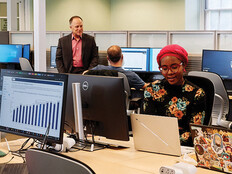Understand Your Technology Lifecycles
Now that some time has passed since many universities first outfitted classrooms for remote and hybrid learning, it’s time to reassess and ask questions: What’s still working? What broke first?
The standard manufacturer warranty range for many classroom products is three to five years, so it stands to reason that something that was purchased in early to mid-2020 is at or near the end of its useful life. Understanding which technologies are the most durable and which will need to be repaired or replaced more often aids future planning and can help tech managers and IT leaders present well-informed plans for future expenditures to administrators.
In general, technology that’s high-touch and products with the most moving parts are likely to be first up for repair or replacement, while tools that function without human hands on them should be expected to last a longer time. Things like touch-screen monitors are going to take more of a beating than a large monitor used only for display at the front of the classroom, for example. Audio tools such as speakers, amplifiers and mounted microphones, meanwhile, should be dependable for years, provided they’re not being abused.
On the other end of the spectrum, pan-tilt-zoom cameras that are regularly in motion will have maybe the shortest lifecycle of anything in the classroom, along with projectors and peripherals, again depending on the level of care.
Some back-end technology could also go quicker than you might think, especially if classrooms and technology spaces are left on 24 hours a day, a practice that also runs counter to university sustainability efforts. Device management platforms can mitigate this problem if administrators set up a schedule to automatically power these tools down after classes are done. If these back-end systems stop working, they can often be repaired or have a single piece replaced to get them back to full health, but that requires savvy troubleshooting and may prolong an interruption in service compared to replacing the whole device.
RELATED: What software asset management programs can do for higher education.
Have a Plan for When Things (Inevitably) Stop Working
If nothing in your classroom has stopped working yet, congratulations. But understand that day is coming.
When things do stop working, a manufacturer’s warranty is the best place to start; but, as mentioned above, those generally don't extend beyond five years. (And any product that doesn’t offer at least a two-year warranty should probably have you asking a lot of questions about why that is.)
In higher education, budgets aren’t often set up to do major replacements even if it does come on a regular schedule based on a thorough device management refresh cycle. To prevent unforeseen expenses, extended warranties are available from partners like CDW and there are both replacement and repair warranties, depending on what an institution prefers.
CDW can help coordinate the execution of these warranties, which isn’t always as easy as it sounds. A partner that has been tracking your purchases should have direct access to the manufacturer to help facilitate repairs and can even contract with a service partner to get onsite to do any needed work.
One other thing to watch for when it comes to repairs is when a product is discontinued. Manufacturers will generally stop servicing technology at that point, or at least once the supply of replacement parts is exhausted. Some tools, such as large video walls, for example, could offer a grace period of a few years after a product is discontinued, but check with the manufacturer or your technology partner when a purchase is made to understand what will happen when particular products are no longer made or supported.
Technology to Facilitate a Return to the Classroom
It’s easy enough to say that the best, most reliable technology is often the most expensive. That’s true with most things. Higher education institutions don’t have unlimited budgets, however, so prioritizing certain tools based on your goals is a must.
There is a renewed push to bring students back to campus to help rebuild the sense of community that makes the college experience so valuable for so many — and to prove to current and prospective students that the investment is worth it.
We’ve seen a spark of interest in technology that can take the in-room experience beyond today’s hybrid teaching and learning capabilities. Immersive classrooms with giant video walls, virtual reality and augmented reality integration, sparkling esports spaces and anything else that gets students excited to step back into the physical room can help a college stand out from the rest.
This article is part of EdTech: Focus on Higher Education’s UniversITy blog series.












